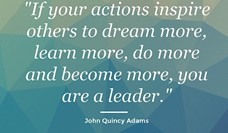Throughout this blog series, we will examine different components and their significance in creating an effective customer experience (CX) program for businesses and organizations. When these elements come together cohesively, they aid in producing a distinctive customer experience that sets companies apart. This blog will focus on the role of middle management within a CX program.
Why is middle management important to a CX program?
Customer experience is one of the most important factors that determine the success of a business. In today's competitive market, providing a positive customer experience has become a key differentiator. When we think about a successful CX program, we often look at front-line employees, collecting customer feedback, and engaging executive leadership. But one group that is often overlooked is the middle management across the organization.
It is important for supervisors and managers to ensure that their teams are delivering a consistent and positive experience to customers. They play a crucial role in creating a customer-centric culture across the organization by communicating the importance of customer experience to their teams and ensuring that everyone in the organization understands how their role impacts the customer. Managers need to lead by example and demonstrate a customer-first mindset in their own actions and decisions. They need to encourage their teams to go above and beyond for customers and empower their employees to make decisions that will improve the customer experience.
When middle management is overlooked
Early on in my career I was part of a program with a local cable operator who wanted to “invert the pyramid” by empowering the employees to make many of the decisions regarding customer issues and not need to escalate to a supervisor or manager. Today this is a common practice within customer centric organizations, but back then this was a very radical departure from the norm. When the project was first rolled out, no new role for middle management had been developed for this new operational paradigm. Managers and supervisors whose role largely had been to handle customer escalations, no longer understood what their primary function was to be within the company and felt completely lost. Once this oversight was realized, the program was quickly modified to establish the new roles of coaching and mentoring as the primary focus for middle management.
A tale of two managers
A few years ago, I had an experience with front-line employees at two different cellular phone stores. After moving to rural area, we needed to switch carriers since our current provider did not provide adequate coverage where we now live. While shopping at a mall several hours away from our home, we stopped in and inquired about a company’s cellular service and phones. After having a great experience with the employee serving us, we decided to visit a store in the town much closer to where we lived. A few days later we went to this second store, only 30 minutes from our home. What we experienced was an employee who was unable to secure the phones we wanted and overall, was very unhelpful. We went home disappointed and began to wonder what would have happened if we had purchased the same phones at the first store. So, I decided to call that store and talk to the same employee we met on our previous visit. He informed us that he could secure the phones that we had selected. He called his manager on his day off to have him approve the transfer of the new phone that needed to come from another store. Several days later we went back to the first store, buying our phones and setting up our service. While in the store, the employee’s manager came in and began to help another customer. I could quickly see why this store’s employee provided such great customer experience – his manager walked the talk – he was the perfect role model to his employees on how to deliver exceptional customer experiences. This made me remember a comment made by the other employee at the second store about how his store manager did not want them “going above and beyond”.
What roles should managers and supervisors play?
Two of the most compelling roles that an organization’s middle management should play to create a dynamic customer centric culture is to lead by example and developing employees who are focused on creating great customer experiences across the organization.
Leading by example
Employees are constantly watching their leaders and learning by how their managers conduct themselves – managers become the primary role models within the organization.
 For managers to successfully lead by example, they must understand what they need to role model. They must recognize how the roles of employees, processes, systems, and decision-making have upon the experiences customers have when interacting with a company. When middle management understands this and demonstrates it every day by walking the talk, then employees will begin to follow the examples portrayed by their manager.
For managers to successfully lead by example, they must understand what they need to role model. They must recognize how the roles of employees, processes, systems, and decision-making have upon the experiences customers have when interacting with a company. When middle management understands this and demonstrates it every day by walking the talk, then employees will begin to follow the examples portrayed by their manager.
Coaching employees
 Managers also have a crucial role in training and developing their team members to deliver exceptional customer experiences. They need to ensure that team members have the necessary skills and knowledge to handle customer inquiries, provide effective communication, problem solving, and conflict resolution.
Managers also have a crucial role in training and developing their team members to deliver exceptional customer experiences. They need to ensure that team members have the necessary skills and knowledge to handle customer inquiries, provide effective communication, problem solving, and conflict resolution.
Coaching today is an integral part of being a great leader within an organization and should be a crucial skillset when hiring or promoting a supervisor or manager. Coaching goes beyond just instructing employees on how to perform the job, it inspires and empowers them to learn, and in this case, how to create the best possible customer experience.
It becomes a powerful combination when managers combine effective coaching with leading by example and can be one of the best methods of instilling a customer focused culture throughout the organization.
Developing a Customer Focused Middle Management
Recognizing the role for managers within a CX program is the first step. The next step is developing a customer focused middle management across the organization. To do this we need to engage the middle management who are focused on the customer experience and support the CX program.
Engaged Leadership
In the article How Your Manager Experience Shapes Your Employee Experience, authors Ben Wigert and Ellyn Maese write: “An employee's interaction with their manager is one of the most important factors for success in all seven stages of the employee journey. If you can get your manager experience right, it will transform and grow every other dimension of your organization -- from culture to performance management to customers and profit.”
Within the CX world we often talk about engaged employees and most of the time we think about the frontline employees. But it is just as important to ensure that our managers and supervisors are engaged. If management is not engaged, then how can we have employees who are engaged? Managers are the conduit between the visions and goals of the CX program and the truths that employees face day in and day out.
Make sure that a component of your CX program includes creating engaged leaders the same as you do by creating engaged employees. Listen to the management across the organization. Find out where they struggle, what drives and motivates them, and where they need your support and assistance.
Leadership development
To have engaged and effective leaders, we need to ensure that we are developing them. When middle management is trained and equipped, then not only will the CX program succeed, but customer experience will continue to improve, and the business will prosper.
- The first place to start in leadership development is to hire and promote the right individuals who have the ability and talent for not only leading a team but understanding the importance of customer experience to the success of the organization.
- Understand and listen to your managers. Know what challenges they face, what tools and training they require, and what recommendations they have.
- Provide them with the resources, training, and recognition that they need to succeed in their role of leading and coaching their employees.
Support for the CX Program
For middle management to have a positive impact upon the CX program, they need to understand the program’s goals and initiatives, to buy into the program and support the program, to provide the resources needed by the program, and to lead by example.
Share the goals and objectives of your CX program, the insights from the customer feedback you have collected, what is being done to address the issues raised by your customers, the results obtained from the improvements, and the overall importance of the program to the company.
Managers must set clear and measurable customer experience goals for their teams. These goals should be aligned with the CX program’s objectives and should focus on improving key customer experience metrics such as NPS, CES, and customer retention. By setting clear goals, managers can motivate their teams to work towards delivering exceptional customer experiences.
Managers should play an active role in building relationships with customers. This could involve reaching out to customers personally to get feedback on their experience, or even visiting customers in person to better understand their needs and challenges. By building strong relationships with customers, managers can gain valuable insights into their needs and preferences, which can help in designing more personalized and effective customer experiences.
Managers should recognize and reward team members who provide exceptional customer experiences. By recognizing and rewarding exceptional customer experiences, managers can motivate their teams to continue providing outstanding experiences for customers. This will help create a culture where providing exceptional customer experience is a top priority.
Conclusion
The role of supervisors and managers in customer experience is critical. They need to create a customer-centric culture within their organization, monitor and improve customer experience, and recognize and reward exceptional customer service. By doing so, managers can ensure that their organizations are providing a positive and consistent experience for customers.
- Do you have a great story to share on the difference a supervisor or manager made within your organization’s customer experience program.
- How do you engage and secure the support of middle management?
- How has your organization succeeded in developing leaders who are focused on customer experience it is role in the success of the organization?










Leave a Comment